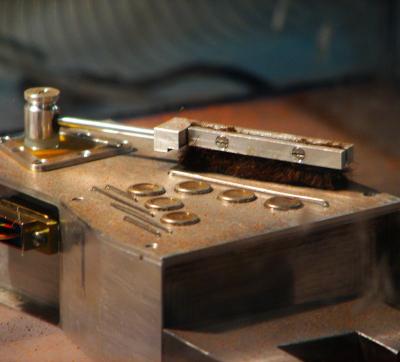Does the dust on Mars cover the solar collectors or the sensors? Engineers and scientists from Spain have developed a lightweight system that will remove the dust from sensitive components. They missed the Curiosity mission

In the past, when the universe t0day website discussed the issue of dust accumulating on the solar collectors of the off-road vehicles exploring Mars - Spirit and Opportunity, the most common comment in the responses was 'why isn't something similar to the wipers of the cars attached to the solar collector to get rid of the dust'. Well, some have taken this advice seriously. A team of researchers from the Carlos III University of Madrid developed an instrument for Curiosity, but unfortunately it was not accepted by NASA for this mission, but it will be ready for the next Mars landing missions.
While Curiosity has no solar collectors because it uses electricity generated from the natural decay of Plutonium 238, it does have sensors that can be affected by the dust build-up, such as the meteorological station. The Spanish team created a brush made of Teflon fibers designed to clean the ultraviolet light sensors on Curiosity's meteorological station.
"In our laboratory we demonstrated how the system works correctly in the extreme conditions it will encounter on Mars." says Prof. Luis Enrique Moreno, who headed the project. "Temperatures range from zero degrees to 80 degrees Celsius below zero and atmospheric pressure one-hundredth that of Earth."
Due to the weight issue, which arises when objects are launched to other worlds, they used extremely light materials to manufacture the wiper arm - shape memory alloys (SMA), a very light alloy composed of nickel and titanium, which allows movement when the component heats up.
The main advantage of the alloy is that it makes it possible to produce materials that are strong in relation to their weight, meaning that a section of less than a millimeter can lift a weight of 4-5 kilograms," Moreno said. The problem presented by this mechanism is that because they are based on heat effects, they are not as efficient as engine technologies, even though they are much lighter, which is especially important in space missions." said.
The group and other researchers from the Carlos III University in Madrid are currently working on a second version of a much more detailed prototype based on SMA technology. It will be used to remove dust from stationary meteorological stations that may be included in the MEIGA-METNET mission - a lander that the Finnish Meteorological Institute is developing together with groups from Russia and Spain to make atmospheric observations on Mars, but is not yet part of an official mission.
"We are using this technology to develop an external skeleton that will be used to help people who suffer from movement problems, in an attempt to replace engines with these materials in order to reduce the weight of the device and reduce the flexibility of using these systems" says Moreno, adding that the new product may even be used in the future to improve the joints and gloves in the astronauts' suits used for space walks.

9 תגובות
Try powwowing on your car window after a foggy day with the window full of dust, and tell me if it was clean enough afterwards to start driving….
A cleaning brush is probably much more effective than just a stream of air.
Do powwow with a less efficient air stream?
In Europe it is customary, so that no one says that someone prefers scientists from one country or another, that all research is on a competitive basis. There is a budget and proposals are submitted, and the most scientifically interesting proposal wins, by the way if you mean the Seventh Framework Program, Israel is also a member of it, and it flows a budget from one side and its scientists win research grants from the other side, and in Israel because it is a research-biased country, the result is always positive in terms of winning compared to the budget.
The European scientific organization whose role is to encourage applied research in space
Gives Spain tiny crumbs to sweep up dust crumbs in space
What is important in aviation is the strength compared to the weight, for example iron looks stronger but in relation to the weight aluminum is much stronger than it. I'm less familiar with sma data..
Mr. Bad translation
Most likely, because nitinol is very hard, it is possible to make components that are much thinner than steel for nothing, and therefore their weight will be lighter, so you are wrong that you only refer to the matter of density
happy holiday and happy new year
Yehuda Sabdarmish
SMA materials such as nitinol are not easy at all:
Density of steel 7.8 g/cmXNUMX
Density of aluminum 2.7 g/cmXNUMX
Density of nitinol 6.5 g/cmXNUMX.
Please check yourself
http://en.wikipedia.org/wiki/Shape_memory
Wow they have developed a cleaning brush, what a revolutionary invention I have never heard of such a thing before.
"The boycotted worlds"?? hook
Guys, although an interesting and informative article, please do some proofreading before publishing.